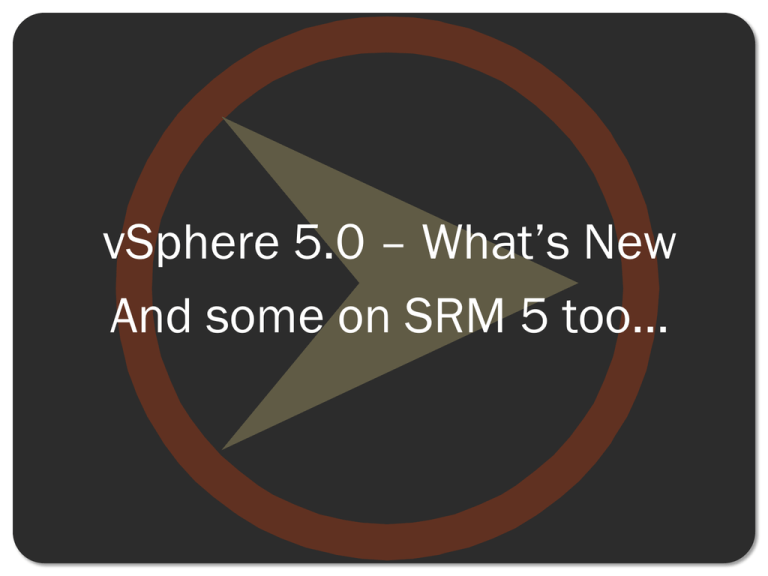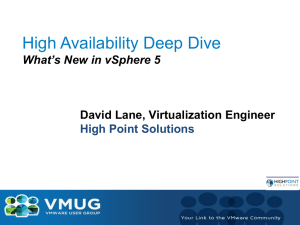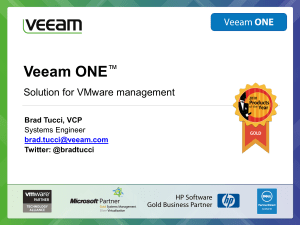FDM
advertisement

vSphere 5.0 – What’s New And some on SRM 5 too… Licensing – Get it out of the way. ©2009 Varrow, Inc. - CONFIDENTIAL Based on Annual Average ©2009 Varrow, Inc. - CONFIDENTIAL In 2011, VMware is Introducing a Major Upgrade of the Entire Cloud Infrastructure Stack… New vCloud Director 1.5 vShield Security 5.0 Cloud Infrastructure Launch SRM 5.0Management vCenter vSphere 5.0 ©2009 Varrow, Inc. - CONFIDENTIAL Agenda vSphere 5.0 What’s New? Welcome vSphere Core CLI Image Builder & Auto Deploy Platform Enhancements What’s New in vCenter Server What’s New in Availability Networking Enhancement Storage Enhancement vSphere Storage Appliance (VSA) ©2009 Varrow, Inc. - CONFIDENTIAL vSphere Core Confidential vSphere 5.0 CLI Components – ESXi Shell • Rebranded Tech Support Mode • Local and remote (SSH) – vCLI • ‘esxcli’ Command Set – Local and remote CLI – New and improved in 5.0 • ‘vicfg’ Command Set – Remote CLI Only • Other Commands: – vmware-cmd, vmkfstools, etc. • vCLI available for Linux and Windows – vMA • vCLI Appliance – PowerCLI • Windows CLI Tool ©2009 Varrow, Inc. - CONFIDENTIAL ESXi Shell vCLI vMA PowerCLI ESXi Command Line esxcli fcoe hardware iscsi fence set load ©2009 Varrow, Inc. - CONFIDENTIAL license Network software Firewall ip vswitch get refresh unload storage nic system vm Composition of an ESXi Image Core Hypervisor CIM Providers Plug-in Components Drivers ©2009 Varrow, Inc. - CONFIDENTIAL Describing ESXi Components • VIB – “VMware Infrastructure Bundle” – Software packaging format used for ESXi • Often referred to as a “Software Package” – Used for all components • ESXi Base Image • Drivers • CIM providers • Other components – Can specify relationship with other VIBs • VIBs that it depends on • VIBs that it conflicts with ©2009 Varrow, Inc. - CONFIDENTIAL What is Auto Deploy •New host deployment method introduced in vSphere 5.0 • Based on PXE Boot • Works with Image Builder, vCenter Server, and Host Profiles • How it works: • • • • PXE boot the server ESXi image profile loaded into host memory via Auto Deploy Server Configuration applied using Answer File / Host Profile Host placed/connected in vCenter • Benefits • • • • No boot disk Quickly and easily deploy large numbers of ESXi hosts Share a standard ESXi image across many hosts Host image decoupled from the physical server • Recover host w/out recovering hardware or having to restore from backup ©2009 Varrow, Inc. - CONFIDENTIAL Auto Depoy Example – Initial Boot Provision new host Depots Image Image Profile Image Profile Profile vCenter Server Rules Engine Host Profile Host Profile Host Profile ESXi VIBs Driver VIBs “Waiter” OEM VIBs Auto Deploy ©2009 Varrow, Inc. - CONFIDENTIAL TFTP DHCP Auto Depoy Example – Initial Boot 1) PXE Boot server Depots Image Image Profile Image Profile Profile vCenter Server Rules Engine Host Profile Host Profile Host Profile ESXi VIBs Driver VIBs “Waiter” OEM VIBs Auto Deploy ©2009 Varrow, Inc. - CONFIDENTIAL gPXE image TFTP DHCP request DHCP Auto Depoy Example – Initial Boot 2) Contact Auto Deploy Server Depots Image Image Profile Image Profile Profile vCenter Server Rules Engine Host Profile Host Profile Host Profile ESXi VIBs Driver VIBs “Waiter” OEM VIBs Auto Deploy ©2009 Varrow, Inc. - CONFIDENTIAL Cluster A Cluster B Auto Depoy Example – Initial Boot 3) Determine Image Profile, Host Profile and cluster Depots Image Image Profile Image Profile Profile ESXi VIBs vCenter Server Rules Engine •Image Profile X •Host Profile 1 •Cluster B Driver VIBs “Waiter” OEM VIBs Auto Deploy ©2009 Varrow, Inc. - CONFIDENTIAL Host Profile Host Profile Host Profile Cluster A Cluster B Auto Depoy Example – Initial Boot 4) Push image to host, apply host profile Depots Image Image Profile Image Profile Profile ESXi VIBs vCenter Server Rules Engine Image Profile Host Profile cache Driver VIBs “Waiter” OEM VIBs Auto Deploy ©2009 Varrow, Inc. - CONFIDENTIAL Host Profile Host Profile Host Profile Cluster A Cluster B Auto Depoy Example – Initial Boot 5) Place host into cluster Depots Image Image Profile Image Profile Profile ESXi VIBs vCenter Server Rules Engine Image Profile Host Profile cache Driver VIBs “Waiter” OEM VIBs Auto Deploy ©2009 Varrow, Inc. - CONFIDENTIAL Host Profile Host Profile Host Profile Cluster A Cluster B Auto Depoy Example –subsequent reboot Reboot Auto Deploy Host Depots Image Image Profile Image Profile Profile ESXi VIBs vCenter Server Rules Engine Image Profile Host Profile cache Driver VIBs “Waiter” OEM VIBs Auto Deploy ©2009 Varrow, Inc. - CONFIDENTIAL Host Profile Host Profile Host Profile TFTP DHCP New Virtual Machine Features • vSphere 5.0 supports the industry’s most capable virtual machines Items which require HW version 8 in Italics VM Scalability Richer Desktop Experience Broader Device Coverage 32 virtual CPUs per VM 3D graphics Client-connected USB devices USB 3.0 devices Smart Card Readers for VM Console Access UI for multi-core virtual CPUs Extended VMware Tools compatibility Other new features ©2009 Varrow, Inc. - CONFIDENTIAL 1TB RAM per VM 4x previous capabilities! VM BIOS boot order config API and PowerCLI interface EFI BIOS Support for Mac OS X servers What’s New in vCenter Server Confidential Current Use Case •The vSphere Web Client is tailored to met the needs of VM Administrators in the first release. This includes: – VM Management • • • • VM Provisioning Edit VM, VM power ops, Snapshots, Migration VM Resource Management View all vSphere objects (hosts, clusters, datastores, folders, etc) – Basic Health Monitoring – Viewing the VM console remotely – Search through large, complex environments • Save search queries, and quickly run them to find detailed information – vApp Management • vApp Provisioning, vApp Editing, vApp Power Operations ©2009 Varrow, Inc. - CONFIDENTIAL Component Overview •vCenter Server Appliance (VCSA) consists of: – A pre-packaged 64 bit application running on SLES 11 • Distributed with sparse disks • Disk Footprint Distribution Min Deployed Max Deployed 3.6GB ~5GB ~80GB • Memory Footprint – A built in enterprise level database with optional support for a remote Oracle databases. – Limits are the same for VC and VCSA • Embedded DB – 5 hosts/50 VMs • External DB – <300 hosts/<3000 VMs (64 bit) – A web-based configuration interface ©2009 Varrow, Inc. - CONFIDENTIAL Configuration •Complete configuration is possible through a powerful web-based interface! ©2009 Varrow, Inc. - CONFIDENTIAL What’s New in Availability Confidential Release Enhancement Summary Complete re-write of vSphere HA Provides a foundation for increased scale and functionality Eliminates common issues (DNS resolution) Multiple Communication Paths Can leverage storage as well as the mgmt network for communications Enhances the ability to detect certain types of failures and provides redundancy IPv6 Support Enhanced Error Reporting One log file per host eases troubleshooting efforts Enhanced User Interface Enhanced Deployment Mechanism ©2009 Varrow, Inc. - CONFIDENTIAL vSphere HA Primary Components •Every host runs an agent – Referred to as ‘FDM’ or Fault Domain Manger – One of the agents within the cluster is chosen to assume the role of the Master ESX 01 ESX 03 ESX 02 ESX 04 • There is only one Master per cluster during normal operations – All other agents assume the role of Slaves •There is no more Primary/Secondary concept with vSphere HA vCenter ©2009 Varrow, Inc. - CONFIDENTIAL vCenter Communications • VC communicates with the Master primarily – Once a Master is elected and contacts vCenter, vCenter sends a compatibility list to the Master. The Master saves this on a local disk, then pushes it out to the other hosts in the cluster. – vCenter also communicates with the Master to update changes to VM states and configuration information. ESX 01 ESX 03 ESX 02 ESX 04 • vCenter may communicate to the Slaves in certain situations, such as: • Scanning for a existing Master • If the Master states that it cannot reach a Slave. In this case, vCenter will try to contact the Slave to determine why. • When powering on a FT Secondary VM • When host is reported isolated or partitioned. vCenter ©2009 Varrow, Inc. - CONFIDENTIAL Storage Level Communications • One of the most exciting new features of vSphere HA is its ability to use a storage subsystem for communication. • The datastores used for this are referred to as ‘Heartbeat Datastores’. • This provides for increased communication redundancy. • Heartbeat datastores are used as a communication channel only when the management network is lost - such as in the case of isolation or network partitioning. vCenter ©2009 Varrow, Inc. - CONFIDENTIAL ESX 01 ESX 03 ESX 02 ESX 04 Failure Scenarios – Network Partition •Occurs when: – Master can see heartbeat datastores – Master can not reach hosts over the management network. Results in: • A Master in each partition • VMs in other partition are: ESX 01 ESX 03 ESX 02 ESX 04 • Monitored via the storage subsystem • Restarted after a host of VM failure • vCenter will only report the state of one of the Masters • When the situation is resolved, the Masters communicate and one is chosen to be the Master. vCenter ©2009 Varrow, Inc. - CONFIDENTIAL Failure Scenarios – Host Network Isolation •Occurs when: – Host is partitioned from the Master and sees no vSphere HA network traffic – The host can not ping the isolation address ESX 01 ESX 03 ESX 02 ESX 04 Results in: • Isolation response applied (if configured and the Master can restart the VMs) • VMs left running are monitored via the storage subsystem and restarted as needed • Note the default isolation response has been changed to Leave Powered On vCenter ©2009 Varrow, Inc. - CONFIDENTIAL Isolation Address Networking Section vSphere 5.0 – What’s New New Networking Features • Two broad categories of features • Network Discovery and Visibility/Monitoring features • LLDP • NetFlow • Port Mirror • IO Consolidation (10 Gig) related features • New traffic types • User Defined Network Resource Pool ( VM traffic ) • Host Based Replication traffic 802.1p Tagging (QoS) TCP IP stack improvement • • • Vmknics will see following improvement • • Higher throughput with small messages Better IOPs scaling for iSCSI traffic ©2009 Varrow, Inc. - CONFIDENTIAL What is Network I/O Control (NETIOC) ? • Network I/O control is a traffic management feature of vSphere Distributed Switch (vDS) • In a consolidated IO (10 gig) deployments this feature allows customer to • Allocate Shares and Limits to different traffic types. – Provide Isolation • One traffic type should not dominate others – Guarantee Service Levels when different traffic types compete •Enhanced Network I/O Control — vSphere 5.0 builds on previous versions of Network I/O Control feature by providing • User-defined network resource pools • New Host Based Replication Traffic Type • QoS tagging ©2009 Varrow, Inc. - CONFIDENTIAL Coke VM Pepsi VMs HBR vMotion Mgmt FT NFS iSCSI Server Admin vNetwork Distributed Portgroup Teaming Policy vNetwork Distributed Switch Load Based Teaming Traffic Shares Limit (Mbps) 802.1p vMotion 5 150 1 Shaper Scheduler Scheduler Mgmt 30 -- NFS 10 iSCSI 10 FT 60 HBR 10 VM 20 Pepsi 5 -- Coke 15 -- 250 2 -- NETIOC VM traffic -2000 ©2008 Varrow, Inc. - CONFIDENTIAL Limit enforcement per team -- 4 Shares enforcement per uplink Network I/O Control Enhancements – Userdefined Network RP ©2009 Varrow, Inc. - CONFIDENTIAL vStorage - What’s new Storage Track vSphere 5.0 – What’s New Introduction to VMFS-5 •Enhanced Scalability • Increase the size limits of the filesystem & support much larger single extent VMFS-5 volumes. • Support for single extent 64TB Datastores •Better Performance – Uses VAAI locking mechanism with more tasks •Easier to manage and less overhead – Space reclamation on thin provisioned LUNs – Smaller sub blocks – Unified Block size ©2009 Varrow, Inc. - CONFIDENTIAL VMFS-5 vs VMFS-3 Feature comparison Feature VMFS-3 VMFS-5 Yes (using extents) Yes Support for 2TB+ Physical RDMs No Yes Unified Block size (1MB) No Yes Atomic Test & Set Enhancements No Yes 64KB (max ~3k) 8KB (max ~30k) No 1KB 2TB+ VMFS Volumes (part of VAAI, locking mechanism) Sub-blocks for space efficiency Small file support ©2009 Varrow, Inc. - CONFIDENTIAL VMFS-3 to VMFS-5 Upgrade •The Upgrade to VMFS-5 is clearly displayed in the vSphere Client under Configuration -> Storage view. •It is also displayed in the Datastores -> Configuration view. •Non-disruptive upgrades. ©2009 Varrow, Inc. - CONFIDENTIAL VAAI - Introduction • vStorage API for Array Integration = VAAI • VAAI’s main purpose is to leverage array capabilities • Offloading tasks to reduce overhead • Benefit from enhanced mechanisms arrays mechanisms • The “traditional” VAAI primitives have been improved • We have introduced multiple new primitives • Support for NAS! ©2009 Varrow, Inc. - CONFIDENTIAL Application VI-3 Hypervisor Non-VAAI Fabric Array VAAI LUN 01 LUN 02 Storage vMotion - Introduction •In vSphere 5.0, a number of new enhancements were made to Storage vMotion. – Storage vMotion will work with Virtual Machines that have snapshots, which means coexistence with other VMware products & features such as VCB, VDR & HBR. – Storage vMotion will support the relocation of linked clones. – Storage vMotion has a new use case – Storage DRS – which use Storage vMotion for Storage Maintenance Mode & Storage Load Balancing (Space or Performance). ©2009 Varrow, Inc. - CONFIDENTIAL Storage vMotion Architecture Enhancements Guest OS VMM/Guest Datamover Mirror Driver VMkernel Userworld Source ©2009 Varrow, Inc. - CONFIDENTIAL Destination What does Storage DRS provide? •Storage DRS provides the following: 1. 2. 3. • Initial Placement of VMs and VMDKS based on available space and I/O capacity. Load balancing between datastores in a datastore cluster via Storage vMotion based on storage space utilization. Load balancing via Storage vMotion based on I/O metrics, i.e. latency. Storage DRS also includes Affinity/Anti-Affinity Rules for VMs & VMDKs; • VMDK Affinity – Keep a VM’s VMDKs together on the same datastore. This is the default affinity rule. • VMDK Anti-Affinity – Keep a VM’s VMDKs separate on different datastores • Virtual Machine Anti-Affinity – Keep VMs separate on different datastores •Affinity rules cannot be violated during normal operations. ©2009 Varrow, Inc. - CONFIDENTIAL Datastore Cluster •An integral part of SDRS is to create a group of datastores called a datastore cluster. • Datastore Cluster without Storage DRS – Simply a group of datastores. • Datastore Cluster with Storage DRS - Load Balancing domain similar to a DRS Cluster. •A datastore cluster , without SDRS is just a datastore folder. It is the functionality provided by SDRS which makes it more than just a folder. 2TB datastore cluster 500GB 500GB 500GB 500GB ©2009 Varrow, Inc. - CONFIDENTIAL datastores Storage DRS Operations – Initial Placement Initial Placement - VM/VMDK create/clone/relocate. •When creating a VM you select a datastore cluster rather than an individual datastore and let SDRS choose the appropriate datastore. •SDRS will select a datastore based on space utilization and I/O load. •By default, all the VMDKs of a VM will be placed on the same datastore within a datastore cluster (VMDK Affinity Rule), but you can choose to have VMDKs assigned to different datastore clusters. 2TB datastore cluster 500GB 500GB 500GB 500GB 300GB 260GB 265GB 275GB available available available available ©2009 Varrow, Inc. - CONFIDENTIAL datastores Storage DRS Operations – Load Balancing Load balancing - SDRS triggers on space usage & latency threshold. • Algorithm makes migration recommendations when I/O response time and/or space utilization thresholds have been exceeded – Space utilization statistics are constantly gathered by vCenter, default threshold 80% – I/O load trend is currently evaluated every 8 hours based on a past day history, default threshold 15ms • Load Balancing is based on I/O workload and space which ensures that no datastore exceeds the configured thresholds. •Storage DRS will do a cost / benefit analysis! •For I/O load balancing Storage DRS leverages Storage I/O Control functionality ©2009 Varrow, Inc. - CONFIDENTIAL So what does it look like? Load Balancing •It will show “utilization before” and “after” •There’s always the option to override the recommendations ©2009 Varrow, Inc. - CONFIDENTIAL What are vStorage APIs Storage Awareness (VASA)? • What are vStorage APIs Storage Awareness (VASA)? • VASA is an Extension of the vSphere Storage APIs, vCenter-based extensions. Allows storage arrays to integrate with vCenter for management functionality via server-side plug-ins or Vendor Providers. • This in turn allows a vCenter administrator to be aware of the topology, capabilities, and state of the physical storage devices available to the cluster. • VASA enables several features. • For example it delivers System-defined (array-defined) Capabilities that enables Profile-driven Storage. • Another example is that it provides array internal information that helps several Storage DRS use cases to work optimally with various arrays. ©2009 Varrow, Inc. - CONFIDENTIAL Storage Capabilities & VM Storage Profiles Not Compliant Compliant VM Storage Profile associated with VM xxx VM Storage Profile referencing Storage Capabilities Storage Capabilities surfaced by VASA or user-defined ©2009 Varrow, Inc. - CONFIDENTIAL vSphere Storage Appliance (VSA) Introducing the vSphere Storage Appliance (VSA) We are basically providing our customers with a low cost, easy to deploy storage appliance which will provide shared storage. • The VSA Manager installation/configuration steps are fool-proof, meaning that an administrator without any SAN skills can deploy it quickly & painlessly. This is a really cool selling point when compared to some other VSAs on the market. • The VSA creates shared storage out of local storage for use by a specific set of hosts. • This means that vSphere HA & vMotion can now be made available on low-end (SMB) configurations, without external SAN or NAS servers. • The vSphere Storage Appliance can be deployed in two configurations: – 2 x ESXi 5.0 servers configuration • Deploys 2 vSphere Storage Appliances, one per ESXi server & a VSA Cluster Service on the vCenter server. – 3 x ESXi 5.0 servers configuration ©2009 Varrow, Inc. - CONFIDENTIAL vSphere Storage Appliance (VSA) How it Works VSA vSphere VSA vSphere VSA vSphere VSA Manager vSphere Client NFS NFS NFS •Each ESXi server has a VSA deployed to it as a Virtual Machine. •The appliances use the available space on the local disk(s) of the ESXi servers & present one replicated NFS volume per ESXi server. This replication of storage makes the VSA very resilient to failures. ©2009 Varrow, Inc. - CONFIDENTIAL What’s New in vCenter Site Recovery Manager 5 Key Components Of SRM 5 vCenter Server Site Recovery Manager Site Recovery Manager • Manages recovery plans • Automates failovers and failbacks • Tightly integrated with vCenter and replication Choice of Replication Options vSphere vSphere Replication • Bundled with SRM • Replicates virtual machines between vSphere clusters Storage Storage-Based Replication (3rd party) • Provided by replication vendor • Integrated via replication adapters created, certified and supported by replication vendor Required at Both Protected and Recovery Sites ©2009 Varrow, Inc. - CONFIDENTIAL What’s New In Site Recovery Manager 5.0? • vSphere Replication • Bundled with SRM at no additional cost • Provides simple, cost-efficient replication between vSphere clusters Expand DR coverage to Tier 2 apps and smaller sites • Automated failback • Bi-directional recovery plans • Automates failback to original site • Planned migration • New workflow that can be applied to any recovery plan • Ensures no data-loss, applicationconsistent migrations of virtual machines • Others • More granular control over VM startup order • Protection-side APIs • IPv6 support ©2009 Varrow, Inc. - CONFIDENTIAL Streamline planned migrations (for disaster avoidance, planned maintenance, …) SRM Provides Broad Choice of Replication Options Site A (Primary) vCenter Server Site B (Recovery) Site Recovery Manager vSphere vCenter Server vSphere Replication Site Recovery Manager vSphere Storage-based replication vSphere Replication Simple, cost-efficient replication for Tier 2 applications and smaller sites Storage-based Replication High-performance replication for business-critical applications in larger sites ©2009 Varrow, Inc. - CONFIDENTIAL vSphere Replication For Cost-Efficient, Simple Replication Cost-efficient Reduce storage costs by 2X • Support for heterogeneous storage across sites, including non-replicating storage • Use lower-end or older storage at failover site Eliminate replication software costs • vSphere Replication included with Site Recovery Manager at no additional cost ©2009 Varrow, Inc. - CONFIDENTIAL Simple Manage replication directly from vCenter • Eliminate complex interactions with storage teams Manage replication at the individual VM level • Eliminate need for complicated VM-to-LUN mapping Powerful 15 minute RPOs • Set RPOs between 15 minutes and 24 hours Efficient network utilization • Replicate only changed disk areas Highly scalable • 500 virtual machines Limitations • No automated failback • File-level consistency only (except planned migration) • No FT, templates, linked clones, physical RDMs Beyond DR: Disaster Avoidance And Planned Migrations 3 typical use-cases for SRM Disaster Failover Recover from unexpected site failure • Full or partial site failure The most critical but least frequent use-case • Unexpected site failures do not happen often • When they do, fast recovery is critical to the business ©2009 Varrow, Inc. - CONFIDENTIAL Disaster Avoidance Planned Migration Anticipate potential datacenter outages • For example: in case of planned hurricane, floods, forced evacuation, etc. Most frequent SRM use case • Planned datacenter maintenance • Global load balancing Initiate preventive failover for smooth migration • Leverage SRM ‘planned migration’ to ensure no dataloss • ‘Automated failback’ enables easy return to original site Streamline routine migrations across sites • Test to minimize risk • Execute partial failovers • Leverage SRM ‘planned migration’ to ensure no data-loss • ‘Automated failback’ enables bidirectional migrations Planned Migrations For App Consistency & No Data Loss Overview Planned Migration 1 Shut down production VMs 3 Recover appconsistent VMs Site A Site B vSphere vSphere Two workflows can be applied to recovery plans: DR failover Planned migration Planned migration ensures application consistency and no data-loss during migration Graceful shutdown of production VMs in application consistent state Data sync to complete replication of VMs Recover fully replicated VMs Benefits Replication 2 Sync data, stop replication and present LUNs to vSphere Better support for planned migrations No loss of data during migration process Recover ‘application-consistent’ VMs at recovery site ©2009 Varrow, Inc. - CONFIDENTIAL Automated Failback To Streamline Bi-Directional Migrations Automated Failback Overview Re-protect VMs from Site B to Site A Reverse replication Apply reverse resource mapping Reverse original recovery plan Site A Site B vSphere vSphere Reverse Replication Automate failover from Site B to Site A Reverse original recovery plan Restrictions Does not apply if Site A has undergone major changes / been rebuilt Not available with vSphere Replication Benefits Simplify failback process Automate replication management Eliminate need to set up new recovery plan Streamline frequent bi-directional migarations ©2009 Varrow, Inc. - CONFIDENTIAL SRM 5 Editions Lineup SRM 5 Price per protected virtual machine (license only) Standard Enterprise $195 $495 Scalability Limits • Maximum protected VMs 75 virtual machines (1) Unlimited(2) Features • Support for storage-based replication • Centralized recovery plans • Non-disruptive testing • Automated DR failover • vSphere Replication • Automated failback • Planned migration 1. 2. Maximum of 75 VMs per site and per SRM instance Subject to the product’s technical scalability limits ©2009 Varrow, Inc. - CONFIDENTIAL New in SRM 5.0 Thank You!







